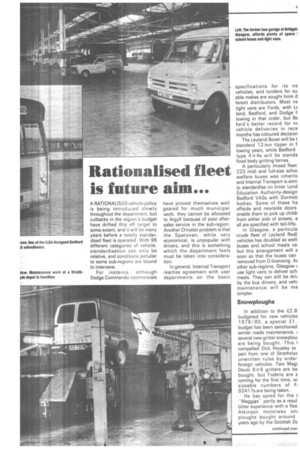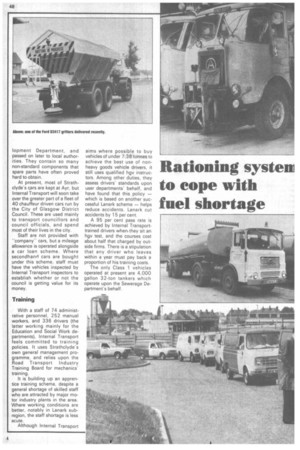Rationalised fleet is future aim...
Page 49

Page 50

If you've noticed an error in this article please click here to report it so we can fix it.
A RATIONALISED vehicle policy is being introduced slowly throughout the department, but cutbacks in the region's budget have drifted this off target to some extent, and it will be many years before a totally standardised fleet is operated. With 98 different categories of vehicle, standardisation can only be relative, and conditions peculiar to some sub-regions are bound to intervene.
For instance, although Dodge Commando commercials have proved themselves well geared for much municipal work, they cannot be allocated to Argyll because of poor aftersales service in the sub-region, Another Chrysler problem is that the Spacevan, while very economical, is unpopular with drivers, and this is something which the department feels must be taken into consideration.
In general, Internal Transport reaches agreement with user departments on the basic specifications for its ne vehicles, and tenders for su
able makes are sought from d ferent distributors. Most nE light vans are Fords, with Lt land, Bedford, and Dodge f lowing in that order, but BE ford's better record for n€ vehicle deliveries in rece months has coloured decision
The Leyland Boxer will be t standard 12-ton tipper in f lowing years, while Bedford type 4 x 4s will be standa fixed body gritting lorries.
A particularly mixed fleet 223 midi and full-size schrx welfare buses was inheritE and Internal Transport is aimi to standardise on Inner Lond Education Authority-design Bedford VASs with DormoL bodies. Some of these ha offside and nearside doors enable them to pick up childr from either side of streets, a all are specified with tail-lifts,
In Glasgow, a particula 'crude fleet of Leyland Redl vehicles has doubled as welt; buses and school meals val but this arrangement will e soon so that the buses can removed from 0-licensing. A! other sub-regions, Glasgow use light vans to deliver sch meals. They can still be dri‘ by the bus drivers, and vehi maintenance will be ma simpler.
Snowploughs In addition to the £2.8 budgeted for new vehicles 1979/80, a special £1. budget has been sanctioned winter roads maintenance, several new gritter snowploul are being bought. This I compelled Dick Housley to part from one of Strathclyc unwritten rules by order foreign vehicles. Two Magi Deutz 6 X 6 gritters are be bought, but Fodens are a coming for the first time, wl sizeable numbers of F, D241 7s are being taken.
He has opted for the "Maggiespartly as a resul bitter experience with a flee Atkinson motorway snr ploughs bought around years ago by the Scottish DE
lopment Department, and passed on later to local authorities. They contain so many non-standard components that spare parts have often proved hard to obtain.
At present, most of Strathclyde's cars are kept at Ayr, but Internal Transport will soon take over the greater part of a fleet of 40 chauffeur driven cars run by the City of Glasgow District Council. These are used mainly to transport councillors and council officials, and spend most of their lives in the city.
Staff are not provided with "company" cars, but a mileage allowance is operated alongside a car loan scheme. Where secondhand cars are bought under this scheme, staff must have the vehicles inspected by Internal Transport inspectors to establish whether or not the council is getting value for its money.
Training
With a staff of 74 administrative personnel, 252 manual workers, and 336 drivers (the latter working mainly for the Education and Social Work departments), Internal Transport feels committed to training policies. It uses Strathclyde's own general management programme, and relies upon the Road Transport Industry Training Board for mechanics' training.
It is building up an apprentice training scheme, despite a general shortage of skilled staff who are attracted by major motor industry plants in the area. Where working conditions are better, notably in Lanark subregion, the staff shortage is less acute.
Although Internal Transport aims where possible to buy vehicles of under 7.38 tonnes to achieve the best use of nonheavy goods vehicle drivers, it still uses qualified hgv instructors. Among other duties, they assess drivers' standards upon user departments' behalf, and have found that this policy — which is based on another successful Lanark scheme — helps reduce accidents. Lanark cut accidents by 15 per cent.
A 95 per cent pass rate is achieved by Internal Transporttrained drivers when-they sit an hgv test, and the courses cost about half that charged by outside firms. There is a stipulation that any driver who leaves within a year must pay back a proportion of his training costs.
The only Class 1 vehicles operated at present are 4,000 gallon 32-ton tankers which operate upon the Sewerage Department's behalf.
































































































































